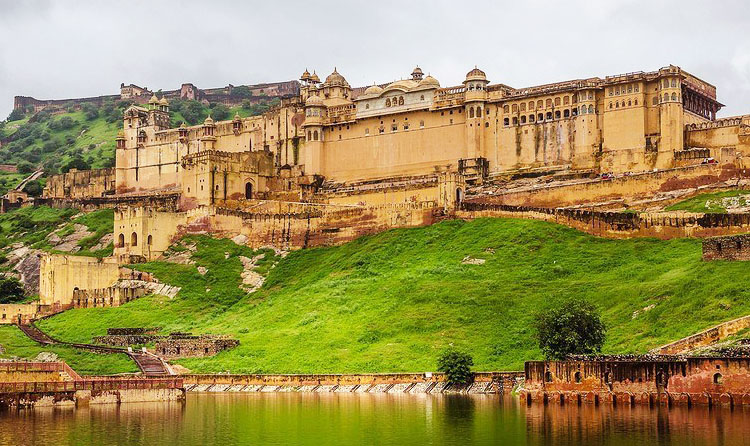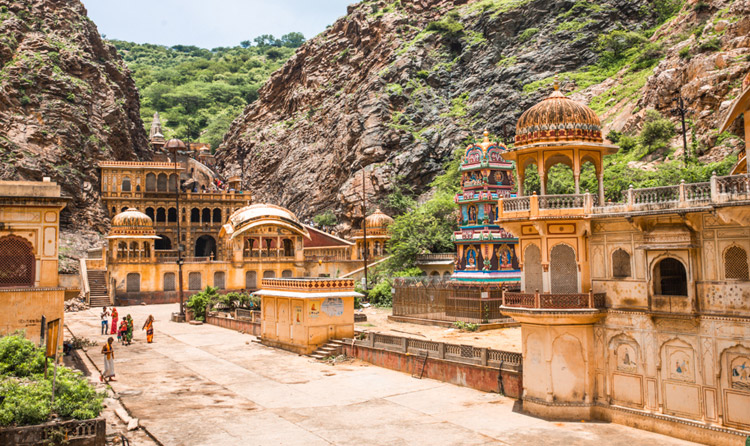Jaipur
Explore Jaipur: Best Time to Visit, How to Reach, and Top Places to Explore in the Pink City
Jaipur, the capital city of the Indian state of Rajasthan, is a vibrant destination known for its rich history, majestic forts, and colorful culture. In this comprehensive guide, we’ll delve into everything you need to know about Jaipur, including the best time to visit, how to reach Jaipur, and the best places to explore in the Pink City.
About Jaipur:
Founded in 1727 by Maharaja Sawai Jai Singh II, Jaipur is famously known as the “Pink City” due to the pink hue of its historic buildings. The city is a captivating blend of ancient traditions and modernity, offering visitors a glimpse into Rajasthan’s royal heritage. From magnificent forts and palaces to bustling bazaars and vibrant festivals, Jaipur is a treasure trove of cultural experiences.
Best Places to Visit in Jaipur:
Amer Fort, Jaipur: Situated atop a hill overlooking Maota Lake, Amer Fort stands as a testament to the rich heritage of Rajasthan. Constructed with sandstone and marble, this majestic fortress boasts a series of intricately designed palaces, courtyards, and temples. Visitors can marvel at the exquisite Sheesh Mahal, adorned with thousands of shimmering mirrors, or explore the historic temples like the Shila Devi shrine. Amer Fort’s architectural splendor and storied past make it a must-visit destination in Jaipur.
Hawa Mahal, Jaipur: Adorning the bustling streets of Jaipur, Hawa Mahal, or the “Palace of Winds,” is an architectural marvel renowned for its unique honeycomb facade. Built by Maharaja Sawai Pratap Singh in 1799, this five-storeyed structure served as a viewing gallery for the royal women, allowing them to observe street festivals and processions while maintaining their privacy. With its 953 intricately carved windows, Hawa Mahal continues to captivate visitors with its beauty and historical significance.
Jantar Mantar, Jaipur: As one of the largest astronomical observatories in the world, Jantar Mantar stands as a testament to India’s rich scientific heritage. Built by Maharaja Sawai Jai Singh II in the 18th century, this UNESCO World Heritage Site comprises a collection of architectural instruments designed for celestial observations. From the monumental Samrat Yantra to the intricate Chakra Yantra, each instrument showcases the ingenuity and precision of ancient Indian astronomers, making Jantar Mantar a fascinating destination for history buffs and astronomy enthusiasts alike.
Jaigarh Fort, Jaipur: Perched atop the Aravalli hills, Jaigarh Fort offers a glimpse into Rajasthan’s martial past and architectural grandeur. Built by Maharaja Jai Singh II in the 18th century, this imposing fortress served as a defensive stronghold for the city of Jaipur. Visitors can explore its massive ramparts, intricate palaces, and expansive courtyards, or marvel at the world’s largest cannon, Jaivana. With its panoramic views of the surrounding landscape, Jaigarh Fort provides a captivating journey through Jaipur’s history and heritage.
City Palace, Jaipur: Nestled in the heart of the Pink City, City Palace stands as a testament to Jaipur’s royal legacy and architectural finesse. Built by Maharaja Sawai Jai Singh II, this sprawling complex boasts a harmonious blend of Rajasthani and Mughal architectural styles. From the ornate Mubarak Mahal to the enchanting Pritam Niwas Chowk, each structure exudes opulence and elegance. Visitors can explore the Maharaja Sawai Man Singh II Museum, home to a remarkable collection of royal artifacts, paintings, and weaponry, offering a glimpse into Jaipur’s regal past.
Albert Hall Museum, Jaipur: Housed in a magnificent Indo-Saracenic building, the Albert Hall Museum is a treasure trove of Rajasthan’s cultural heritage and artistic prowess. Built in the late 19th century, this museum showcases a diverse collection of artifacts, including ancient sculptures, miniature paintings, and decorative arts. Visitors can marvel at the grandeur of its architecture, adorned with intricate carvings and ornamental domes, while exploring the rich tapestry of Rajasthan’s history and culture.
Royal Tombs in Gaitor, Jaipur: Tucked away amidst the tranquil surroundings of Gaitor, the royal tombs stand as silent sentinels to Jaipur’s regal past. Adorned with intricate carvings, latticework, and sculptural details, these cenotaphs pay homage to the erstwhile rulers of the Kachwaha dynasty. Visitors can wander through the serene complex, admiring the architectural splendor and paying their respects to the illustrious Maharajas and Maharanis of Jaipur.
Nahargarh Fort, Jaipur: Perched on the rugged hills of the Aravallis, Nahargarh Fort offers a breathtaking panorama of Jaipur’s skyline and surrounding landscape. Built in the 18th century by Maharaja Sawai Jai Singh II, this formidable fortress served as a defensive stronghold for the city. Visitors can explore its imposing ramparts, historic palaces, and picturesque gardens, or visit the mesmerizing Sheesh Mahal, adorned with intricate mirror work. With its rich history and stunning vistas, Nahargarh Fort offers a captivating journey through Jaipur’s past and present.
Jal Mahal, Jaipur: Nestled amidst the tranquil waters of Man Sagar Lake, Jal Mahal is a symphony of Rajput and Mughal architectural styles. Built in the 18th century, this enchanting palace offers a mesmerizing glimpse into Jaipur’s royal heritage. Visitors can admire its exquisite sandstone facade, adorned with intricate carvings and ornamental details, while enjoying the serene beauty of the surrounding landscape. With its idyllic setting and architectural splendor, Jal Mahal remains a timeless symbol of Jaipur’s elegance and charm.
Galta Ji: Tucked away in the serene outskirts of Jaipur, Galta Ji is a sacred temple complex surrounded by natural beauty. Built in the 16th century, this architectural gem showcases traditional Rajasthani craftsmanship, with intricately carved pillars and vibrant frescoes. Visitors can explore the tranquil courtyards, adorned with ancient shrines and sacred pools, while soaking in the spiritual ambiance of this revered site. With its serene surroundings and architectural splendor, Galta Ji offers a peaceful retreat from the hustle and bustle of city life.
Abhaneri Step Well: Located about 95 kilometers from Jaipur, Abhaneri Step Well, also known as Chand Baori, is a mesmerizing architectural marvel dating back to the 9th century. This ancient stepwell, dedicated to the goddess Harshat Mata, comprises over 3,500 steps and 13 storeys, showcasing exquisite carvings and geometric patterns. Visitors can descend into the depths of this remarkable structure, marveling at its intricate design and historical significance. With its captivating beauty and cultural heritage, Abhaneri Step Well offers a fascinating journey into Rajasthan’s rich architectural legacy.
Each of these historical places in Jaipur offers a unique glimpse into the city’s rich heritage, architectural splendor, and cultural legacy. Whether exploring the majestic forts and palaces or admiring the intricate craftsmanship of ancient temples and stepwells, visitors are sure to be captivated by the timeless charm of the Pink City.
Best Time to Visit Jaipur:
The best time to visit Jaipur is during the winter months, from October to March, when the weather is pleasant and conducive to outdoor exploration. The temperature during this period ranges from 10°C to 25°C, making it ideal for sightseeing and enjoying various outdoor activities. Additionally, this time coincides with several festivals and events, adding to the city’s vibrant atmosphere.
How to Reach Jaipur:
Jaipur is well-connected to major cities in India by air, rail, and road, making it easily accessible for travelers from all over the country.
- By Air: Jaipur International Airport serves as the primary gateway to the city, with regular flights connecting it to major Indian cities such as Delhi, Mumbai, and Bangalore. From the airport, travelers can hire taxis or use public transportation to reach their desired destination within Jaipur.
- By Train: Jaipur Junction Railway Station is a major railway hub, with trains connecting Jaipur to various cities across India, including Delhi, Mumbai, Kolkata, and Chennai. The train journey offers a scenic view of the countryside and is a convenient option for travelers seeking a budget-friendly mode of transportation.
- By Road: Jaipur is well-connected to neighboring cities and states via a network of national and state highways. The city is easily accessible by road from Delhi, Agra, Udaipur, and other prominent destinations. Travelers can opt for state-run buses, private taxis, or self-driven cars to reach Jaipur by road.
Conclusion: In conclusion, Jaipur, the Pink City of India, offers a captivating blend of rich history, architectural splendor, and vibrant culture. From the majestic forts and palaces to the serene temples and stepwells, each historical site showcases the city’s royal legacy and artistic brilliance. With its pleasant weather during the winter months and excellent connectivity by air, rail, and road, Jaipur welcomes visitors to immerse themselves in its timeless charm and explore the wonders of Rajasthan’s capital.
Useful Links
Day Tours
Tours Packages
Visit us
Address : 5, Sansar Chandra Road, Anaj Mandi, Jalupura, Jaipur, Rajasthan 302016
Phone : +91-9587869215
Email : info@jaipurtourtaxi.com












